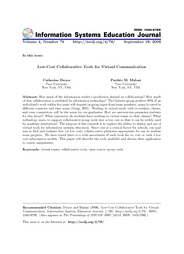Volume 4
Volume 4, Number 78 |
September 19, 2006 |

|
Catherine Dwyer
Parthiv M. Malani
|
Abstract: How much of the information worker's production depend on collaboration? How much of that collaboration is mediated by information technology? The Gartner group predicts 60% of an individual's work within five years will depend on group input from team members, many lo-cated in different countries and time zones (Grigg, 2001). Working in virtual mode with co-workers, clients, and even competitors will be the norm for our graduates. How are universi-ties preparing students for this future? What experience do students have working in virtual teams in their classes? What technology exists to support collaborative group work that is low cost so that it can be widely used by academic institutions? The purpose of this research is to explore the ability to deploy and use of virtual tools for information systems education. Since cost is a critical factor for schools, our goal was to find and evaluate free (or low cost) collabo-rative platforms appropriate for use in student team projects. We have found there is a wide assortment of such tools for no cost or with a low cost subscription models. This paper will describe the tools available and discuss their application to course assignments.
Keywords: virtual teams, collaborative tools, open source, group work
Download this issue: ISEDJ.4(78).Dwyer.pdf (Adobe PDF, 11 pages, 1530 K bytes)
Preview the contents: Dwyer.j.txt (ASCII txt, 24 K bytes)
Recommended Citation: Dwyer and Malani (2006). Low-Cost Collaborative Tools for Virtual Communication. Information Systems Education Journal, 4 (78). http://isedj.org/4/78/. ISSN: 1545-679X. (A preliminary version appears in The Proceedings of ISECON 2005: §4114. ISSN: 1542-7382.)